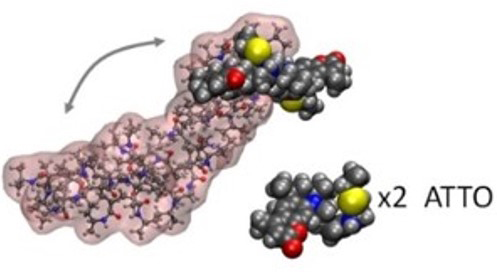In this chemical physics analysis, Professor Vladik Avetisov and his team are searching for oligomeric compositions that behave like nonlinear mechanical systems
With my two teams from the Moscow Design Center of the Molecular Machine Corporation and the Semenov Institute of Chemical Physics of the Russian Academy of Sciences, we are searching for oligomeric compositions, which are only a few nanometres in size, that behaves like nonlinear mechanical systems.
In fact, this topic goes deep into the problem of the origin of life. People have always been aware of the striking difference between living and nonliving objects. The deeper our understanding of wildlife and the greater our knowledge of molecular biology, the grander this difference became.
Chemistry
There are many reasons to believe that life is a special phenomenon. In a broad sense, life is a chemistry, but it is a very peculiar type of chemistry. Chemical transformations in a living cell are not at all what happens in a test tube. In the tube, even if only a few molecular collisions out of millions of collisions result in the right chemical transformations, the reaction in the tube will have a reasonable yield. This is stochastic chemistry, nothing more. In biochemistry, the opposite is true. The assembling of even complex molecular structures in a cell is carried out with fantastic accuracy, with only a few faulty structures among millions of perfect copies. Moreover, all this is realised in a stochastically effected environment.
Molecular machines
In contrast to stochastic chemistry, the living world seems to be the embodiment of the natural technology of precise operation at the molecular level. This technology is implemented by specific molecular structures, which we call biological molecular machines. “Machines” might seem like an impressive metaphor, but biological molecular machines indeed act like machines. Proteins, for instance, recognise individual molecules, pick them up, move them around a cell, assemble complex macromolecules, and transfer and rewrite terabytes of genetic information.

The assembly of cellular molecular machines in a cell is carried out by biological molecular machines. In this regard, a cell itself is a self-reproducing machine. But, how did nature create the primer molecular machines? Nobody yet knows.
Nonetheless, human intelligence and ingenuity are directed towards the design of synthetic molecular machines. The diversity of potential applications of synthetic molecular machines cannot be overestimated. Many scientists forecast that, in the medium term, molecular machines will lead to a technological revolution with dramatic changes in the development of new materials, supersensitive detection abilities, health diagnostics, the direction of individual cells, non-invasive treatment of critical diseases, and even integration of the human brain with computer nets.
The modern molecular machine technology is at an initial stage. It is based on the ingenuity of chemists in the synthesis of molecular machines as “molecular artifacts” directly from the smallest building blocks, such as atoms or small molecules. We do not doubt the impressive achievements along the way. Chemists similar to the 2016 Nobel Prize winners, being highly intelligent and very skilled “biological machines”, can make almost any molecular artifact. However, nature could not follow that path. It had to use a different strategy. Which one? This is the question.
In contrast to the atom-to-atom strategy, our strategy is based on an idea of direct utilisation of oligomeric building blocks, themselves a few nanometres in size, which possess the reproducible dynamics inherent in mechanical systems, but also possess high sensitivity to weak impacts typically characteristic of microsystems.
Nanomechanics
To reconcile these two conflicting requirements, we have focused on three physical criteria. The first is the nanomechanics. This enables us to realise machine-like movements using molecular blocks of a nanometre scale. Machine-like movement implies the reproducible movements of a “solid” molecular block, the atomic fluctuations of which are much less than the block characteristic size. Since the block atomic fluctuations at ordinary conditions can be roughly estimated in 1 Angstrom, the size of the molecular blocks should not be significantly less than 1 nanometre.
The second criterion is the advantage of utilising oligomers and co-oligomer compositions. Oligomers can be used to make nanometre-sized rigid blocks, and at the same time, it is natural to combine these into an oligomeric composition to realise reproducible mechanical motion.
The third criterion is the conformational bistability of oligomeric compositions. The bistability is characterised, on the one hand, by the presence of two well distinguishable conformational states and, on the other hand, by reproducible or spontaneous transitions between the two conformational states controlled by some external parameter. Bistable oligomeric systems made from the oligomeric blocks a few nanometres in size enable the realisation of the mechanical-like movements at the nanometre scale. At the same time, the spontaneous vibration and the stochastic resonance might be used to detect molecules in the environment with extremely high sensitivity.
To translate these ideas into reality, the Molecular Machine Corporation has organised and is funding the Molecular Machine Project. Within the framework of this project, the Design Center of Molecular Machine Corporation Ltd (Tel Aviv, Israel) – in collaboration with the Semenov Institute of Chemical Physics (Moscow, Russia) – is implementing a bistable oligomeric machines approach.
In particular, using a full atomic computer simulations technique, the research team found bistable oligomeric compositions a few nanometres in size made from such thermoresponsive polymers as poly-N-isopropylacrylamide and poly-N-isopropylacrylmethacrylamide. We show that oligomeric compositions made using these polymers satisfy the three criteria of our strategy.
It is necessary to emphasise that the spontaneous vibrations and stochastic resonance activated by ordinary thermal-bath fluctuations are the outstanding characteristics of the bistable oligomeric systems. They open up new horizons in the development of nanodevices for various purposes. Now it is up to the design and in-depth study of the bistable oligomeric machines.
*Please note: This is a commercial profile











